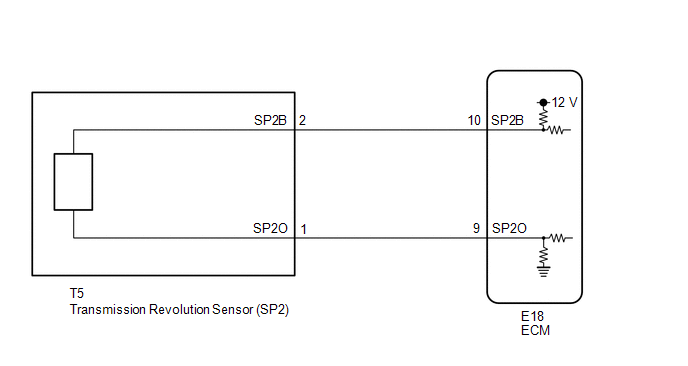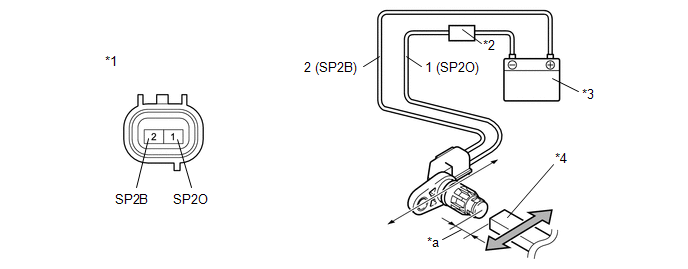Toyota Tacoma (2015-2018) Service Manual: Output Speed Sensor Circuit No Signal (P0722,P077C,P077D)
DESCRIPTION
This sensor detects the rotation speed of the transmission output shaft and sends signals to the ECM. By comparing the input turbine speed signal (NT) with the output shaft speed sensor signal (SP2), the ECM detects the shift timing of the gears and appropriately controls the engine torque and hydraulic pressure according to various conditions. As a result, the gears shift smoothly.
|
DTC Code |
DTC Detection Condition |
Trouble Area |
|---|---|---|
|
P0722 |
All conditions are met for 5 seconds or more (2 trip detection logic): (a) Park/neutral position switch D input signal is ON. (b) Either condition is met.
(c) The vehicle speed is 8.99 km/h (5.59 mph) or more. (d) No signal from transmission revolution sensor (SP2) is input to the ECM. |
|
|
P077C |
When the transmission revolution sensor (SP2) input voltage is below 0.2 V for 4.5 seconds or more (2 trip detection logic). |
|
|
P077D |
When the transmission revolution sensor (SP2) input voltage is higher than 1.8 V for 4.5 seconds or more (2 trip detection logic). |
|
MONITOR DESCRIPTION
The transmission revolution sensor (SP2) detects the transmission output shaft speed. The ECM calculates gear shifts comparing the transmission revolution sensor (NT) with the transmission revolution sensor (SP2).
If the ECM detects no signal from the transmission revolution sensor (SP2) even while the vehicle is moving, it will conclude that there is a malfunction in the transmission revolution sensor (SP2). The ECM will illuminate the MIL and store the DTC.
MONITOR STRATEGY
|
Related DTCs |
P0722: Transmission revolution sensor (SP2)/Verify pulse input P077C: Transmission revolution sensor (SP2)/Range check (Low voltage) P077D: Transmission revolution sensor (SP2)/Range check (High voltage) |
|
Required sensors/Components |
Transmission revolution sensor (NT), Transmission revolution sensor (SP2) |
|
Frequency of operation |
Continuous |
|
Duration |
P0722: 5 sec. P077C, P077D: 4.5 sec. |
|
MIL operation |
2 driving cycles |
|
Sequence of operation |
None |
TYPICAL ENABLING CONDITIONS
All:|
Battery voltage |
8 V or higher |
|
Ignition switch |
ON |
|
Starter |
OFF |
|
Vehicle speed |
8.99 km/h (5.59 mph) or more |
|
Shift change |
Shift change is completed before starting next shift change operation |
|
R position switch |
OFF |
|
Park/neutral position switch (NSW) |
OFF |
|
Engine |
Running |
|
Transmission range switch circuit fail (P0705) (Pending + MIL) |
Not detected |
|
Output speed sensor range check fail (P077C, P077D) (Pending / MIL) |
Not detected |
|
Either of the following conditions is met |
Conditions 1 or 2 |
|
1. All of the following conditions are met |
- |
|
ECM selected gear |
1st |
|
Turbine speed sensor revolution |
1310 rpm or more |
|
2. All of the following conditions are met |
- |
|
ECM selected gear |
Not 1st |
|
Turbine speed sensor revolution |
760 rpm or more |
|
Output speed sensor pulse input fail (P0722) (Pending / MIL) |
Not detected |
TYPICAL MALFUNCTION THRESHOLDS
P0722:|
Output speed sensor signal |
No signal |
|
Output speed |
Below 0.2 V |
|
Output speed |
Higher than 1.8 V |
WIRING DIAGRAM

CAUTION / NOTICE / HINT
NOTICE:
- Perform the universal trip to clear permanent DTCs (See page
.gif) ).
). - Perform registration and/or initialization when parts related to the
automatic transmission are replaced (See page
.gif) ).
).
HINT:
After the repair, clear the DTCs and perform the following procedure to check that DTCs are not output.
- Perform the D Position Shift Test in Road Test (See page
.gif) ).*1
).*1 - Turn the ignition switch off.
- Perform step (*1) again.
- Check for DTCs again (See page
.gif) ).
).
1. DATA LIST
HINT:
Using the Techstream to read the Data List allows the values or states of switches, sensors, actuators and other items to be read without removing any parts. This non-intrusive inspection can be very useful because intermittent conditions or signals may be discovered before parts or wiring is disturbed. Reading the Data List information early in troubleshooting is one way to save diagnostic time.
NOTICE:
In the table below, the values listed under "Normal Condition" are reference values. Do not depend solely on these reference values when deciding whether a part is faulty or not.
(a) Warm up the engine.
(b) Turn the ignition switch off.
(c) Connect the Techstream to the DLC3.
(d) Turn the ignition switch to ON.
(e) Turn the Techstream on.
(f) Enter the following menus: Powertrain / Engine and ECT / Data List.
(g) According to the display on the Techstream, read the Data List.
Engine and ECT|
Tester Display |
Measurement Item/Range |
Normal Condition |
Diagnostic Note |
|---|---|---|---|
|
SPD (SP2) |
Output shaft speed/ Min.: 0 km/h (0 mph) Max.: 255 km/h (158 mph) |
0 km/h (0 mph): Vehicle stopped (equal to vehicle speed) |
- |
HINT:
- SPD (SP2) is always 0 while driving: Open or short in the sensor or circuit.
- SPD (SP2) value displayed on the Techstream is much lower than the actual vehicle speed: Sensor trouble, improper installation, or intermittent connection trouble of the circuit.
PROCEDURE
|
1. |
READ VALUE USING TECHSTREAM (SPD (SP2) AND SP2 SENSOR VOLTAGE) |
(a) Connect the Techstream to the DLC3.
(b) Turn the ignition switch to ON.
(c) Turn the Techstream on.
(d) Enter the following menus: Powertrain / Engine and ECT / Data List
(e) In accordance with the display on the Techstream, read the Data List.
Engine and ECT|
Tester Display |
Measurement Item/Range |
Normal Condition |
Diagnostic Note |
|---|---|---|---|
|
SPD (SP2) |
Output shaft speed/ Min.: 0 km/h (0 mph) Max.: 255 km/h (158 mph) |
0 km/h (0 mph): Vehicle stopped (equal to vehicle speed) |
- |
|
SP2 Sensor Voltage |
Transmission revolution sensor (SP2) output voltage/ Min.: 0.000 V Max.: 4.999 V |
0.1 to 1.9 V: Engine idling |
- |
|
Result |
Proceed to |
|---|---|
|
Data display is not within Normal Condition range |
A |
|
Data display is within Normal Condition range |
B |
| B | .gif) |
REPLACE ECM |
|
|
2. |
INSPECT TRANSMISSION REVOLUTION SENSOR (SP2) |
(a) Remove the transmission revolution sensor (SP2) (See page
.gif) ).
).
(b) Connect the battery to the sensor as shown in the illustration.
 Text in Illustration
Text in Illustration
|
*1 |
Transmission Revolution Sensor (SP2) |
*2 |
Ammeter |
|
*3 |
Battery |
*4 |
Magnet |
|
*a |
5 mm (0.197 in.) or less |
- |
- |
(c) Wave a magnetic object left and right in front of the transmission revolution sensor (SP2) tip (5 mm (0.197 in.) or less) to change the high/low signals while measuring the current.
NOTICE:
Make sure to wave the magnetic object during the inspection. The current will not change without waving the magnetic object as indicated by the arrow in the illustration.
(d) Measure the current according to the value(s) in the table below.
Standard Current:
|
Tester Connection |
Condition |
Specified Condition |
|---|---|---|
|
1 (SP2O) - 2 (SP2B) |
Low signal |
4 to 8 mA |
|
1 (SP2O) - 2 (SP2B) |
High signal |
12 to 16 mA |
| NG | .gif) |
REPLACE TRANSMISSION REVOLUTION SENSOR (SP2) |
|
|
3. |
CHECK HARNESS AND CONNECTOR (TRANSMISSION REVOLUTION SENSOR (SP2) - ECM) |
(a) Disconnect the T5 transmission revolution sensor (SP2) connector.
(b) Disconnect the E18 ECM connector.
(c) Measure the resistance according to the value(s) in the table below.
Standard Resistance:
|
Tester Connection |
Condition |
Specified Condition |
|---|---|---|
|
T5-2 (SP2B) - E18-10 (SP2B) |
Always |
Below 1 Ω |
|
T5-1 (SP2O) - E18-9 (SP2O) |
Always |
Below 1 Ω |
|
T5-2 (SP2B) - Body ground |
Always |
10 kΩ or higher |
|
T5-1 (SP2O) - Body ground |
Always |
10 kΩ or higher |
| OK | .gif) |
REPLACE ECM |
| NG | .gif) |
REPAIR OR REPLACE HARNESS OR CONNECTOR |
 Input Speed Sensor Circuit No Signal (P0717,P07BF,P07C0)
Input Speed Sensor Circuit No Signal (P0717,P07BF,P07C0)
DESCRIPTION
This sensor detects the rotation speed of the turbine which shows the input turbine
speed of the transmission. By comparing the input turbine speed signal (NT) with
the output shaft s ...
 Transmission Fluid Temperature Sensor "A" Performance (P0711)
Transmission Fluid Temperature Sensor "A" Performance (P0711)
DESCRIPTION
The No. 1 ATF temperature sensor converts the fluid temperature into a resistance
value for use by the ECM.
The ECM applies a voltage to the temperature sensor through terminal THO1 of ...
Other materials:
On-vehicle Inspection
ON-VEHICLE INSPECTION
PROCEDURE
1. INSPECT INSTRUMENT PANEL PASSENGER AIRBAG ASSEMBLY WITHOUT DOOR (for Vehicle
not Involved in Collision)
(a) Perform a diagnostic system check (See page
).
(b) With the instrument panel passenger airbag ...
Communication Error from VSC to ECM (P1630)
DESCRIPTION
The skid control ECU (brake actuator assembly) sends signals such as cruise control
cancel signals and brake demand response signals to the ECM when the dynamic radar
cruise control system is operating.
DTC No.
Detection Item
DTC Detection Condition ...
Removal
REMOVAL
CAUTION / NOTICE / HINT
HINT:
Use the same procedure for the RH and LH sides.
The procedure listed below is for the LH side.
PROCEDURE
1. REMOVE FRONT DOOR LOWER FRAME BRACKET GARNISH
(See page
)
2. REMOVE FRONT DOOR INSIDE HANDLE BEZEL PLUG
(See page
)
3. ...

.gif)